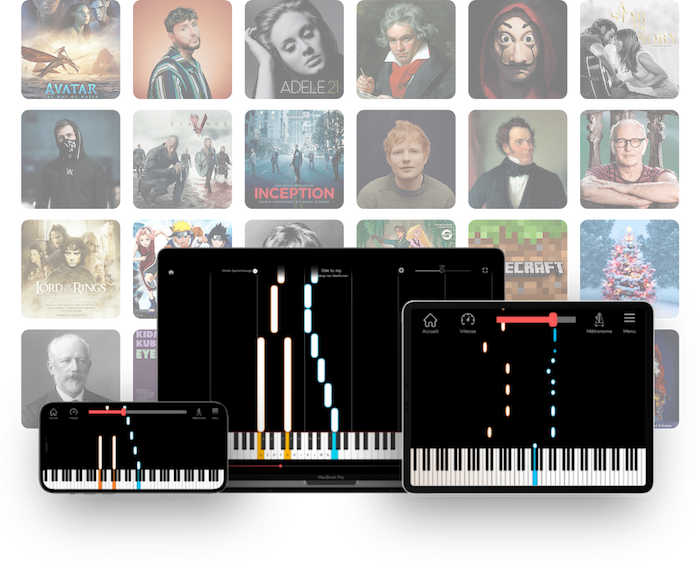
Would you like to learn how to play the notes from The Phantom of the Opera on the piano? You’ve come to the right place!
In 1986, Andrew Lloyd Webber composed the music for The Phantom of the Opera for the musical of the same name. Initially created to promote musical comedy, the musical quickly became a huge success in Britain. The music was inspired by Gaston Leroux’s novel Le Fantôme de l’Opéra, which tells the story of a tragic love affair.
In this article, we’ll guide you through playing the famous music from The Phantom of the Opera. We’ll start by learning the notes for the right hand, followed by those for the left. Once you’re comfortable, we’ll show you how to play with both hands simultaneously.
Throughout the article, we’ll provide practical tips and video tutorials to help you. At the end, you’ll also be able to download the sheet music for free.
Ready, set, go!
Bonus : you can also learn to play this song at your own pace on our interactive piano learning app La Touche Musicale.
Free download: >> >> The guide to learn 10 easy piano pieces.
Learn to play your favorite songs on the piano
The La Touche Musicale learning app offers more than 2,500 songs to play easily on the piano. Connect your piano to your device and learn to play them at your own pace while having fun.
First of all, before diving into the haunting melody of The Phantom of the Opera, let’s go back to piano basics. You’ll learn how to find your way around a piano keyboard with the help of the illustration below:

The name of the notes on a piano keyboard.
Look closely at the diagram of the piano keyboard above. You’ll see that the black keys follow a regular pattern: two keys, then three, and this is repeated all along the keyboard.
To start exploring the notes, concentrate on the groups of two black keys. The white key immediately to the left of each group is the C note, and the one to the right is the E note. This way, you can easily locate all the C and E notes on your keyboard. Use this method to identify other notes based on the groups of black keys.
By playing notes to the left of your keyboard, you move down into the low register, while playing to the right moves up into the high register.
This is the key to mastering The Phantom of the Opera. Once you’ve mastered these concepts, practice regularly to familiarize yourself with all the notes on the piano. If you have difficulty at first, associate each note with a specific color to make it easier to identify. You can also learn to recognize the intervals between notes, which will make it easier to find them.
Congratulations, you now know your way around a piano keyboard! Now we can dive into the musical world of The Phantom of the Opera.
To begin with, we’ll show you the first notes to be played with the right hand: these are F + A + D.

The notes F + A + D are the first notes to be played with your right hand for The Phantom of the Opera on piano.
Congratulations! You’ve successfully played the first notes with your right hand on your keyboard. Now we’re going to learn all the other notes for the right hand.
F + A + D – F + A + D – E + G# + C# – D# + G + C – D + F# + B – D + F + A# – C + D# + G# – D + F + A# – F + A + D – F + A + D – E + G# + C# – D# + G + C – D + F# + B – D + F + A# – C + D# + G# – D + F + A# – D + F + A# – D + F# + B – D# + G + C – E + G# + C# – F + A + D – A – F + D – A – C + D + G – A# – D + G + A# – C + E – G – C + E + C – G – D + F + A – G + C – A + D – A – F + D – A – C + D + G – A# – D + G + A# – C + E – G – C + E + C – G – D + F + A – D + A – F + D – A + F – A# + D + A – G – A# + D + G – C + E – G – C + E + C – G – D + F + A – D + F + A – D + F + A + D – C – A# – A – G – F – E – D – G + C# – E – A# – E + G + A# – A – D + F + A – F + A + D – E + G# + C# – D# + G + C – D + F# + B – D + F + A# – C + D# + G# – D + F + A# – E + G# + C# – D# + G + C – D + F# + B – C# + F + A# – A# + D + G – D – A# + G – D – F + G + C – D# – G + C + D# – F + A – C – F + A + F – C – G + A# + D – D – A# + G – D – F + G + C – D# – G + C + D# – F + A – C – F + A + F – C – G + A# + D – G + D – A# + G – D + A# – D# + G + D – C – D# + G + C – F + A – C – F + A + F – C – G + A# + D – G + A# + D – G + A# + D + G – F – D# – D – C – A# – A – G – D# + F# – A – D# – A + C + D# – D – A# + D + G – A# + D + G – A + C# + F# – G# + C + F – G + B + E – G + A# + D# – D + F# + A – C – E – G – B – B – G + E – B – D + E + A – C – E + G + C – D + F# – A – D + F# + D – A – E + G + B – B – G + E – B – D + E + A – C – E + G + C – D + F# – A – D + F# + D – A – E + G + B – E + B – G + E – B + G – C + E + B – A – C + E + A – D + F# – A – D + F# + D – A – E + G + B – E + G + B – E + G + B + E – D – C – B – A – G – F# – E – C + D# – F# – C – D# + F# + C – B – B + E + G – F# – G + B + F# – E – G + B + E – E – G + C + E – C + E + B – E – E + G + B – F# – G + B + F# – E – G + B + E – E – G + C + E – C + E + B – G# + C + F – F – A# – F – G# – A# – G# – D# + G + A# – F + G# + C – C – G# + F – C – D# + F + G# – C# – F + G# + C# – D# + G – A# – D# + G + D# – A# – F + G# + C – C – G# + F – C – D# + F + G# – C# – F + G# + C# – D# + G – A# – D# + G + D# – A# – F + G# + C – F + C – G# + F – C + G# – C# + F + C – A# – C# + F + A# – D# + G – A# – D# + G + D# – A# – F + G# + C – F + G# + C – F + G# + C + F – D# – C# – C – A# – G# – G – F – E + G – A# + C# – A# + C# – G# + C + F – F + G# + C – G – G + G# + C – F – F + G# + C – F – F + G# + C# – C – F + G# + C – F + G# + C – G – G# – G + G# + C – F – F + G# + C – F – G# + C# + F – F + G# + C – C# + F + G# – G – G# – G – G# – C – F – G – G# – C – F – D# – G# + C# + F – C# + F + G# – D + G + A# – A – A# – A – A# – D – G – A – A# – D – G – F – A# + D# + G – D# + G + A# – D + G + A# – A – A# – A – A# – D – G – A – A# – D – G – F – A# + D# + G – D# + G + A# – E + A + C – B – C – B – C – E – A – B – C – E – A – G – C + F + A – F + A + C – E + A + C – F + A + C – E + A + C – E + A + C + E
Did you manage to play all these notes? To help you, try to identify the musical notes that repeat. At first sight, this piece may seem complex, but by identifying the passages where the notes repeat, you’ll be able to play it with greater ease.
Once you’re comfortable with the right-hand notes, we’ll move on to learning the left-hand ones.
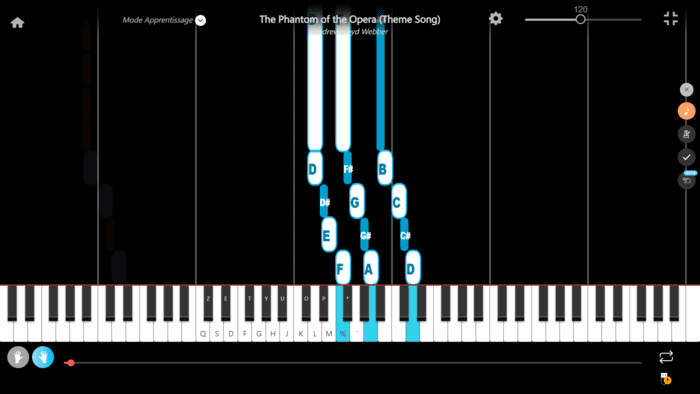
The Phantom of the Opera on the piano: the notes of the right hand.
To make learning easier, we recommend you watch this video, which shows all the notes to be played with the right hand.
By watching this video, you can familiarize yourself with the location of each note and the rhythm to be followed. You’ll be able to play each note on your keyboard in sync with those displayed on the virtual keyboard.
Feel free to watch this tutorial as many times as necessary to fully assimilate the information.
Congratulations, you’ve now mastered all the right-hand notes! Let’s move on to learning left-hand notes.
But what’s the difference between the right and left hands on the piano? The right hand generally plays the main melody, while the left hand accompanies this melody by playing chords or basses.
La Touche Musicale app waits for you to play the right note with your right hand on your piano before moving on to the next one.
For the left hand, we’ll follow the same procedure as for the right hand.
First, we’ll identify the first note to be played: the note D

The note D is the first note to be played with your left hand for the song The Phantom of the Opera on piano.
Congratulations on successfully playing the first note of the left hand of The Phantom of the Opera on your piano! Excellent work! Now let’s continue by playing all the left-hand notes in succession. Simply play them one by one on your keyboard.
D – D – D – D – D – D – D – D – D – D – D – D – D – C# – C – B – A# – A# – A# – A# – A# – A# – A# – A# – G# – A# – A# – A# – A# – A# – A# – A# – D – D – D – D – D – D – D – D – D – D – D – D – D – C# – C – B – A# – A# – A# – A# – A# – A# – A# – A# – G# – A# – A# – A# – A# – B – C – C# – D – D – D – D – D – D – D – D – D – D – D – D – D – D – D – D – G – G – G – G – G – G – G – G – C – C – C – C – C – C – C – C – D – D – D – D – D – D – D – C – D – D – D – D – D – D – D – D – G – G – G – G – G – G – G – G – C – C – C – C – C – C – C – C – D – D – D – D – D – D – D – D – D – D – D – D – D – D – D – D – A# – A# – A# – A# – A# – A# – A# – A# – C – C – C – C – C – C – C – C – D – D – D – D – D – D – D – C – D – D – D – D – D – D – D – D – D – D – D – D – D – D – D – D – D – D – D – D – D – D – D – D – A# – A# – A# – A# – A# – A# – A# – A# – A# – A# – A# – A# – A# – A# – A# – A# – D – D – D – D – D – D – D – D – D – D – D – D – D – C# – C – B – A# – A# – A# – A# – A# – A# – A# – A# – G# – A# – A# – A# – C# – C – B – A# – G – G – G – G – G – G – G – G – G – G – G – G – G – G – D – D – C – C – C – C – C – C – C – C – F – F – F – F – F – F – F – F – G – G – G – G – G – G – D – D – G – G – G – G – G – G – D – D – C – C – C – C – C – C – C – C – F – F – F – F – F – F – F – F – G – G – G – G – G – G – D – D – G – G – G – G – G – G – D – D – D# – D# – D# – D# – D# – D# – D# – D# – F – F – F – F – F – F – F – F – G – G – G – G – G – G – G – D – G – G – G – G – G – G – D – D – G – G – G – G – G – G – D – D – G – G – G – G – G – G – G – D – C – C – C – C – C – C – C – C – F# – F# – F# – F# – F# – F# – F# – F# – G – G – G – G – G – G – G – G – G – G – G – G – G – F# – F – E – D# – D# – D# – D# – D# – D# – D# – D# – D – D – D – D – D – D – D – D – E – E – E – E – E – E – E – E – E – E – A – A – A – A – A – F# – F# – F# – F# – F# – B – B – B – B – B – B – B – B – B – B – A – A – A – A – A – F# – F# – F# – F# – F# – B – B – B – B – B – B – B – B – B – B – C – C – C – C – C – D – D – D – D – D – E – E – E – E – D – E – E – E – E – B – B – E – E – E – E – E – E – E – E – E – E – C – C – C – C – C – C – C – C – C – C – E – E – E – E – E – E – E – E – E – E – E – E – E – D# – D – C# – C – C – C – C – C – C – C – C – C – C – C – C – C – C# – D – D# – E – E – E – E – E – E – E – E – E – E – E – E – E – D# – D – C# – C – C – C – C – C – C – C – C – C – C – C – C – C – C# – D – E – F – D# – F – F – F – F – F – F – F – F – C# – C# – C# – D# – D# – D# – D# – F – F – F – F – F – F – F – F – C# – C# – C# – D# – D# – D# – D# – F – F – F – F – F – F – F – F – D# – C – C# – C# – D# – D# – D# – D# – F – F – F – D# – F – F – F – F – F – F – F – F – F – F – F – F – C# – C# – C# – C# – C# – C# – C# – F – F – F – F – F – F – F – F – F – F – F – F – F – F – F – F – C# – C# – C# – C# – C# – C# – C# – C# – C# – C# – C# – C# – C# – D – D# – E – F – F – F – F – F – F – F – F – F – F – F – F – F – F – F – F – C# – C# – C# – C# – C# – C# – C# – C# – C# – C# – C# – C# – C# – D – D# – E – F – F – F – D# – F – F – F – F – F – F – F – F – F – E – D# – D – C# – C# – C# – B – C# – C# – C# – C# – C# – C# – C# – C# – C# – D# – F – F# – G – G – G – F – G – G – G – G – G – G – G – G – G – F# – F – E – D# – D# – D# – C# – D# – D# – D# – D# – D# – D# – D# – D# – D# – E – F – F# – G – G – G – F – G – G – G – G – G – G – G – G – G – F# – F – E – D# – D# – D# – C# – D# – D# – D# – D# – D# – D# – D# – D# – D# – F – F# – G – A – A – A – G – A – A – A – A – A – A – A – A – A – G# – G – F# – F – F – F – D# – F – F – F – F – F – F – F – F – F – F# – G – G# – A – A – A – G – A – A – A – A – A – A – A – A – A – G# – G – F# – F – F – F – D# – F – F – F – F – F – F – F – F – F – F# – G – G# – A – A – A – G – A – A – A – A – A – A – A – A – A – G# – G – F# – A + E
Have you managed to play all the notes with your left hand? To improve your playing, practice repeating these notes over and over until you feel comfortable.
Once you’ve done that, you can move on to learning The Phantom of the Opera by playing with both hands simultaneously.
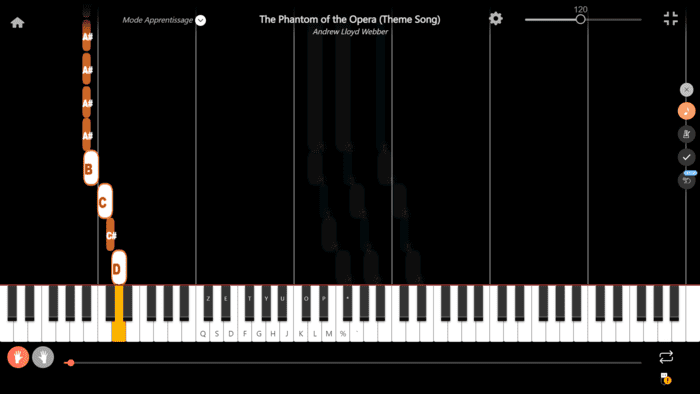
The Phantom of the Opera on the piano: the notes of the left hand.
To make things easier, we’ve prepared a video tutorial for you.
We recommend that you watch this video to make learning more enjoyable. Play the notes shown on the on-screen virtual keyboard one after the other on your piano.
At first, you can slow down the pace of the video to familiarize yourself with the musical notes.
The La Touche Musicale app waits for you to play the correct note with your left hand on your piano before moving on to the next.
Congratulations, you’ve now mastered all the right and left hand notes of The Phantom of the Opera.
We’ll now guide you through synchronizing your two hands so that you can play the entire piece with both hands simultaneously.
Playing the piano simultaneously with both hands can be a challenge for many pianists, especially beginners. Coordinating the movements of both hands while maintaining a precise rhythm can seem complex. Fortunately, the La Touche Musicale app can help you progress at your own pace, offering invaluable support.
To overcome this obstacle, practice exercises in which both hands play different scores at different rhythms. This will go a long way to improving coordination between the two hands.
Remember, patience is important, so don’t be too hard on yourself. Fun and enjoyment are essential to progress.

The Phantom of the Opera on the piano: the notes of both hands.
In this last video, you’ll learn how to play The Phantom of the Opera with both hands simultaneously on the piano. Follow the notes on the screen and play them on your keyboard. If the pace of the video is too fast, you can slow it down or pause it.
However, pausing to adjust your fingers or go back can be tedious. For a smoother experience, consider using the La Touche Musicale application. This interactive application accompanies you as you learn, and can be connected directly to your piano. It will wait for you to play the notes correctly before moving on. We recommend that you use this application in conjunction with our guide for optimum progress.
What’s more, our app offers a vast selection of tunes to suit all styles and skill levels. Whatever your level, it will help you progress and perfect your playing. Are you ready to join us now?
Ajoutez votre titre ici
The La Touche Musicale app waits for you to play the right notes with both hands on your piano before moving on to the next.
Congratulations! You’ve given a brilliant piano performance of The Phantom of the Opera. You can be proud of your performance. However, to maintain the positive momentum, it’s essential to keep practicing. We invite you to discover three other tutorials that are sure to catch your interest:
The main aim of this article was to guide you through learning The Phantom of the Opera on the piano. However, we think it would be beneficial for you to have a score at hand, enabling you to play this piece wherever you are. To download the score, please click on this link.
If you’re looking for a personalized learning experience, tailored to your own pace and needs, we also recommend downloading our La Touche Musicale app.
Share the article on:
La Touche Musicale offers powerful AI apps to help you learn, play, and transcribe music effortlessly. Discover them below.
Ideal for: solo piano

Transcribe your piano pieces to sheet music with unrivalled precision.
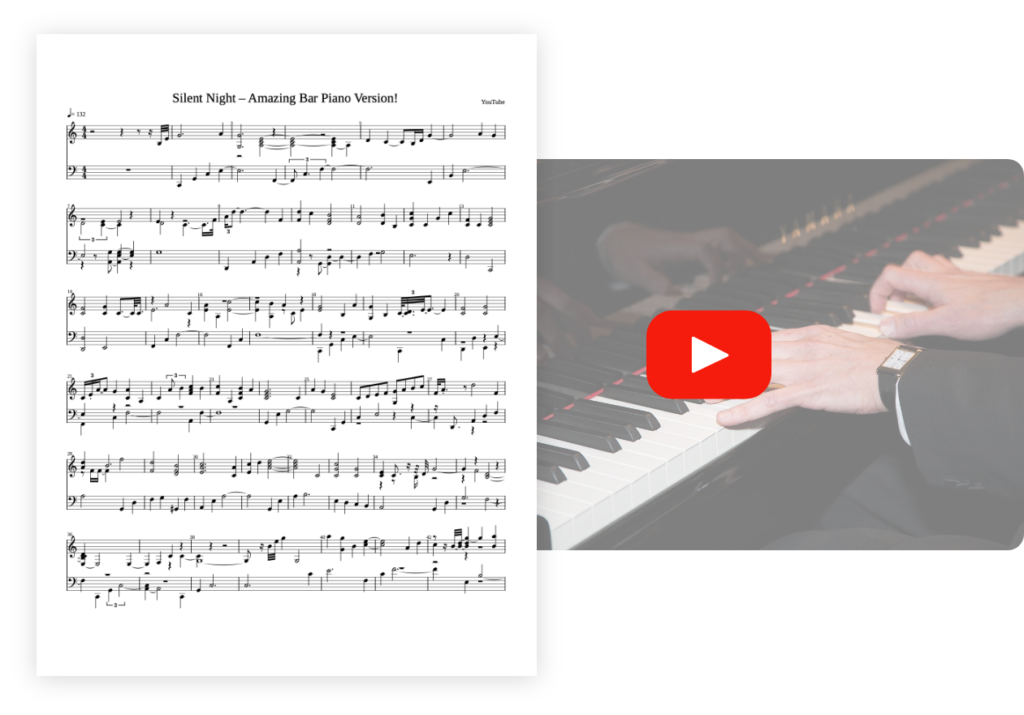
Ideal for: solo guitar

Transcribe your guitar tunes into tablature with unrivalled precision.
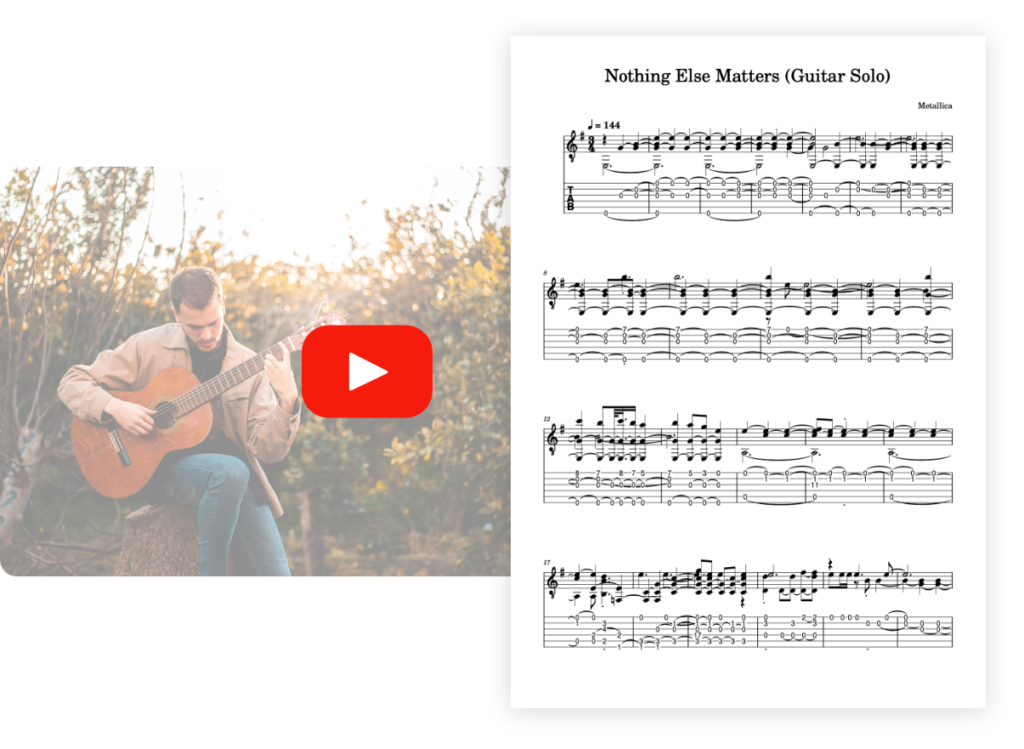
Ideal for: solo vocals

Transcribe your vocal recordings into sheet music with unrivalled precision.
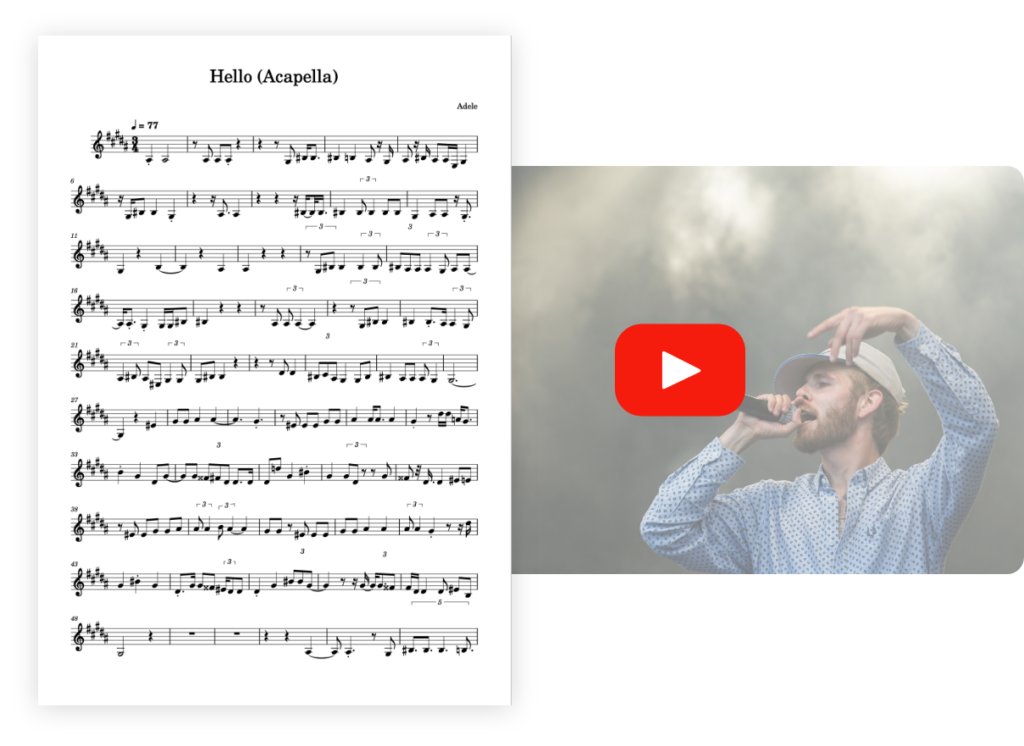
Ideal for: multi-instruments

Transcribe your multi-instrument tracks into sheet music with unrivalled precision.
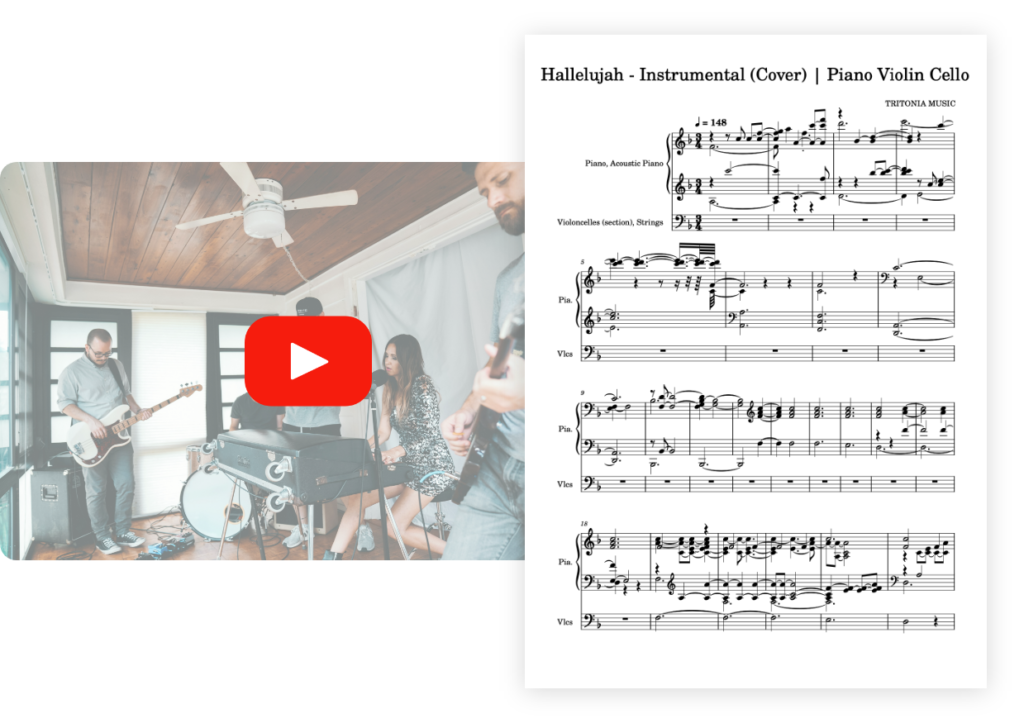
Ideal for: solo drums

Transcribe your drum tracks into sheet music with unrivalled precision.

Ideal for: solo violin

Transcribe your violin pieces into sheet music with unrivalled precision.
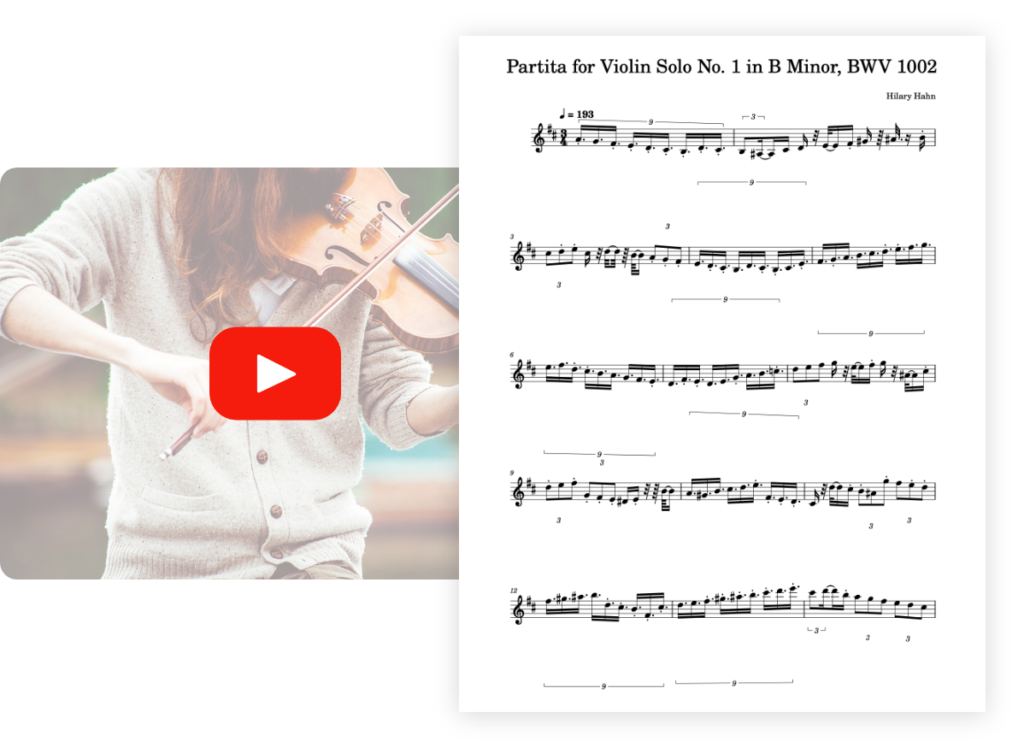
Optimized for: solo saxophone 🎷

Transcribe your saxophone pieces into sheet music with unrivaled precision.

Optimized for : solo flute 🪈

Transcribe your flute pieces into sheet music with unrivaled precision.
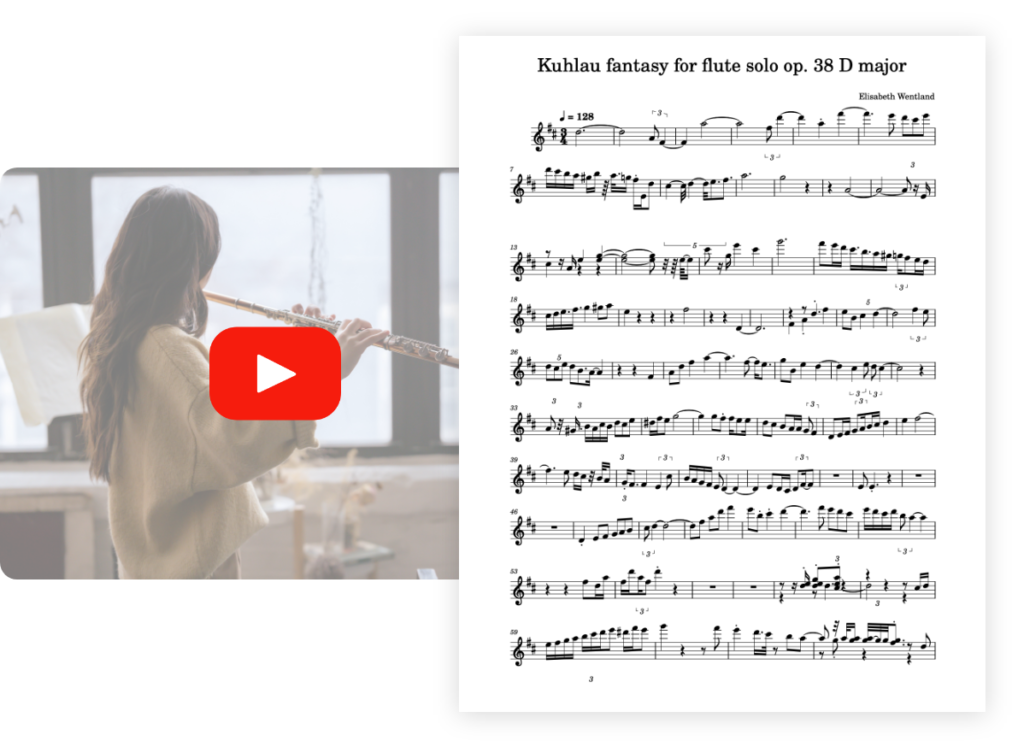
Optimized for : solo bass 🪕

Transcribe your bass pieces into sheet music with unrivaled precision.
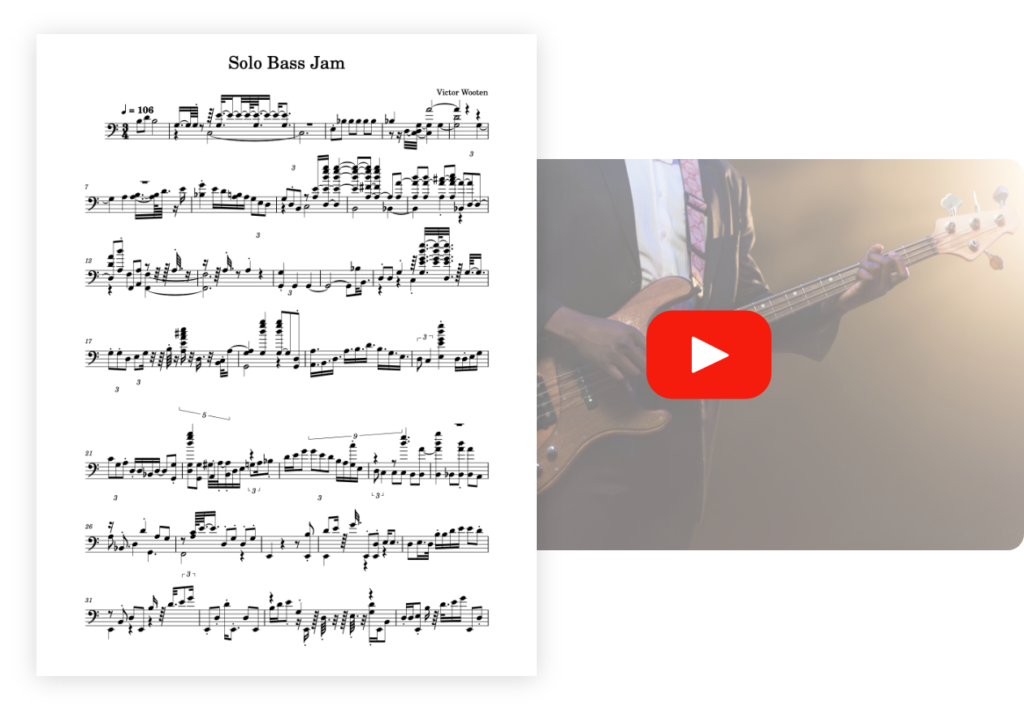
PianoGo lets you learn to play over 3,000 songs easily on the piano.
